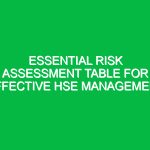Introduction
Risk assessment techniques are vital tools in the Health, Safety, and Environment (HSE) domain, serving as a structured process to identify, analyze, and mitigate risks associated with workplace Hazards. The significance of these techniques cannot be overstated; they not only protect employees and the environment but also enhance organizational efficiency and compliance with legal requirements. In an era where Safety is paramount, understanding and implementing effective risk assessment techniques is crucial for any organization.
Imagine a manufacturing facility where equipment malfunctions frequently, leading to accidents and environmental spills. Without proper risk assessment techniques, the management may overlook critical Hazards, resulting in severe consequences. Conversely, a facility that employs comprehensive risk assessment techniques can proactively identify and address these risks, fostering a safer and more sustainable operational environment. This article delves into the essential risk assessment techniques pertinent to HSE management, exploring their methodologies, benefits, and real-world applications.
Understanding Risk Assessment Techniques
Risk assessment techniques encompass a variety of methodologies aimed at evaluating potential hazards in the workplace. These techniques involve several key steps:
- Hazard Identification: This is the first step in the risk assessment process, where potential hazards are recognized. Hazards can arise from various sources, including machinery, chemicals, environmental conditions, and human factors.
- Risk Analysis: Once hazards are identified, the next step is to analyze the risks associated with them. This involves determining the likelihood of an incident occurring and the potential severity of its consequences.
- Risk Evaluation: In this phase, the analyzed risks are compared against established risk criteria to determine their significance. This helps prioritize which risks need immediate attention.
- Risk Control Measures: After evaluating risks, organizations must implement Control Measures to mitigate them. This can involve engineering controls, administrative policies, or Personal Protective Equipment (PPE).
- Monitoring and Review: Finally, continual monitoring and review of the risk assessment process are essential to ensure its effectiveness. This includes updating risk assessments as conditions change or new hazards emerge.
Key Risk Assessment Techniques in HSE Management
Several specific risk assessment techniques are widely utilized in the HSE context. Each technique has its strengths and is suited for different scenarios.
1. Qualitative Risk Assessment
Qualitative risk assessment is a subjective method that involves evaluating risks based on non-numerical data. This technique is often used when quantitative data is scarce or when quick assessments are necessary. A common approach is to categorize risks into high, medium, and low based on their likelihood and impact.
For instance, in a chemical plant, a qualitative assessment might identify the risk of chemical exposure as high due to frequent handling of hazardous materials, while the risk of equipment failure might be rated as medium. This technique allows organizations to prioritize risks and allocate resources effectively without extensive data collection.
2. Quantitative Risk Assessment
In contrast to qualitative methods, quantitative risk assessment relies on numerical data to evaluate risks. This technique involves statistical analysis and often employs mathematical models to predict risk levels. For example, an organization might use historical data on workplace accidents to calculate the probability of future incidents.
A real-world application of quantitative risk assessment can be seen in the oil and gas industry, where companies use this technique to model potential spills and their environmental impact. By quantifying risks, organizations can make informed decisions on Safety Measures and emergency preparedness.
3. Bowtie Analysis
Bowtie analysis is a visual risk assessment technique that illustrates the relationship between hazards, their potential consequences, and the controls in place to mitigate those risks. The diagram resembles a bowtie, with the hazard at the center, preventive measures on the left side, and recovery measures on the right.
This technique is particularly effective for complex operations where multiple risks are present. For example, in a construction project, a bowtie analysis might identify risks such as falls from height and outline both preventive measures (like Safety harnesses) and recovery measures (like first-aid Training).
4. Failure Mode and Effects Analysis (FMEA)
FMEA is a systematic approach to identify potential failure modes within a system and assess their impact on operations. This technique is widely used in manufacturing and engineering sectors. By analyzing how and why a system might fail, organizations can develop strategies to mitigate those risks.
In practice, FMEA might be employed in the automotive industry to evaluate potential failures in vehicle components. By addressing these failures during the design phase, manufacturers can enhance safety and reliability.
5. Hazard and Operability Study (HAZOP)
HAZOP is a structured and systematic technique used to identify and evaluate potential hazards in a process. This method involves a team of experts who review the design of a process and identify deviations from the intended Operation that could lead to hazards.
For example, in a chemical processing plant, a HAZOP study might identify that a failure in temperature control could lead to a chemical reaction that poses safety risks. By systematically analyzing each part of the process, organizations can implement safeguards to prevent such incidents.
Benefits of Implementing Risk Assessment Techniques
The use of effective risk assessment techniques in HSE management offers numerous Benefits:
- Enhanced Safety: By identifying and mitigating risks, organizations can create safer work environments, reducing the likelihood of accidents and injuries.
- Regulatory Compliance: Many industries are subject to legal requirements regarding safety and environmental management. Implementing risk assessment techniques helps organizations comply with these Regulations.
- Improved Decision-Making: Risk assessment provides valuable insights that inform decision-making processes, enabling organizations to prioritize safety initiatives and allocate resources effectively.
- Cost Savings: By preventing accidents and minimizing environmental damage, organizations can save on costs associated with incident management, insurance, and regulatory fines.
- Employee Engagement: Involving employees in the risk assessment process fosters a culture of safety, encouraging them to take ownership of their own safety and that of their colleagues.
Regulations and Standards Governing Risk Assessment Techniques
Several regulations and standards govern the implementation of risk assessment techniques in the HSE context. Understanding these requirements is essential for compliance and effective risk management.
1. Occupational Safety and Health Administration (OSHA)
In the United States, osha sets forth regulations that require employers to assess workplace hazards and implement appropriate Safety Measures. OSHA’s General Duty Clause mandates that employers provide a safe working environment free from recognized hazards. Risk assessment techniques play a crucial role in fulfilling this obligation.
2. ISO 45001
ISO 45001 is an international standard for Occupational Health and safety management systems. It emphasizes the need for organizations to identify hazards, assess risks, and implement control measures. Compliance with ISO 45001 enhances organizational safety culture and demonstrates a commitment to employee well-being.
3. Environmental Protection Agency (EPA)
The EPA establishes regulations related to environmental hazards and pollution. Organizations must conduct risk assessments to identify potential environmental impacts and develop mitigation strategies. Compliance with EPA regulations not only protects the environment but also enhances an organization’s reputation.
Conclusion
In conclusion, effective risk assessment techniques are indispensable for robust HSE management. By employing methodologies such as qualitative and quantitative assessments, bowtie analysis, FMEA, and HAZOP, organizations can systematically identify, analyze, and mitigate risks. The benefits of implementing these techniques—ranging from enhanced safety to regulatory compliance—underscore their importance in promoting health, safety, and environmental Sustainability.
Moreover, as industries evolve and new risks emerge, continuous monitoring and adaptation of risk assessment techniques will be crucial. Organizations should not only comply with existing regulations but also foster a culture of safety that engages all employees in the risk management process. By doing so, they pave the way for a safer and more sustainable future, ensuring that health, safety, and environmental concerns remain at the forefront of their operations.


